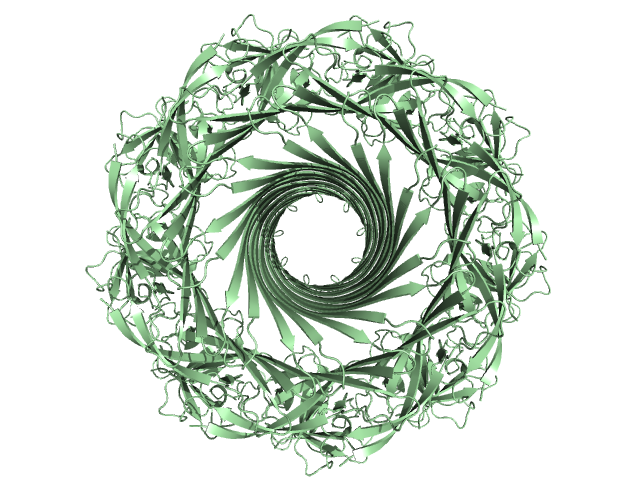A recent collaboration between scientists from the PDBe team, local arts societies Camdfas and Grantadfas, and arts students in local schools has led to some amazing results. One is currently on display in a Cambridge gallery.
Vivian, from The Leys school in Cambridge, was part of a group who visited us at EMBL-EBI last year. She explored 3D protein structures in the PDB archive with scientists from the PDBe team. The students have created some very exciting artworks, surprising the scientists with how their proteins can be portrayed.
Vivian was inspired by the structure of lysenin, a pore-forming toxin from a common garden earthworm. The protein protects the worm from infection by the many bugs it shares your compost heap with by boring holes in their membranes. These holes are just 3 millionths of a millimeter across, but that’s easily big enough to kill the bugs by allowing their cell contents to leak out.
By chance, the scientist who discovered what lysenin looks like, Christos Savva, is also based in Cambridge at the MRC Laboratory of Molecular Biology (LMB).
PDBe were able to arrange for Vivian to meet Christos at the opening of the exhibition of artworks by The Leys students at the Michaelhouse Gallery. Vivian and Christos are pictured here in front of Vivian’s painting.
Vivian explained “I am showing the protein being sucked into a vortex. I have used colours to illustrate the movement as the protein punches holes in cell membranes.”
Christos commented, “The artwork is very dark, and captures very well the destructive and dynamic nature of this toxin.”

Lysenin (PDB entry 5gaq) shown in cartoon view, a view scientists often use to look at protein structures.
Vivian will study biomedical sciences at Imperial College next year, and hopes one day to have a career which combines her artistic skills with sciences. Her art teacher Jessica Hebden said of the project “It really has been the firework that has started the A level off properly for her!”
Despite its dark side, which Vivian has nicely captured, this toxic protein has exciting uses in medicine. Because it can attack and kill specific types of cells it is an ideal candidate for developing treatments which target certain cells types, such as cancers.
This artwork on display in the Michaelhouse Gallery in Cambridge as part of The Leys VI Form Exhibition until 11th March.
The lysenin structure, published last year in Nature Communications, can be seen at the PDBe website, with accession code 5gaq


